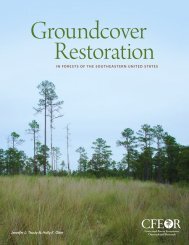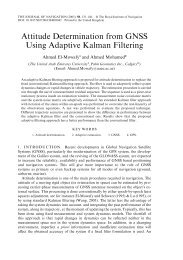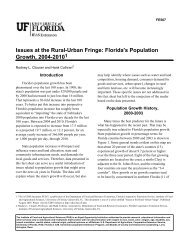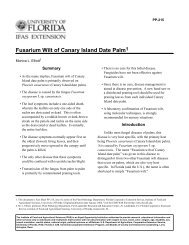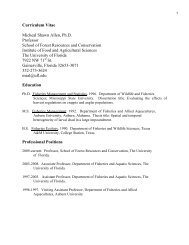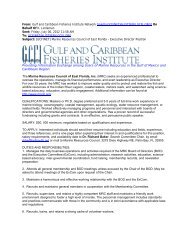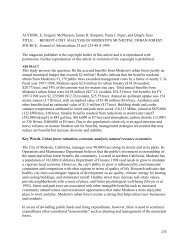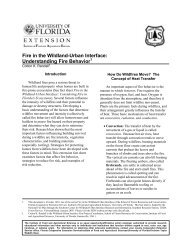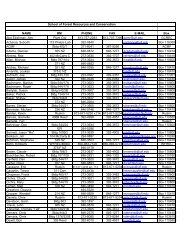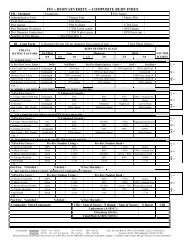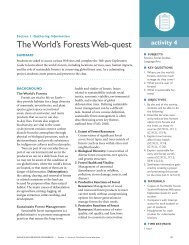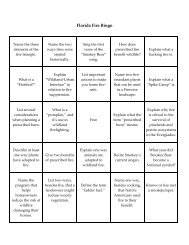Chapter 4: Plant Succession and Disturbances in the Urban Forest ...
Chapter 4: Plant Succession and Disturbances in the Urban Forest ...
Chapter 4: Plant Succession and Disturbances in the Urban Forest ...
Create successful ePaper yourself
Turn your PDF publications into a flip-book with our unique Google optimized e-Paper software.
<strong>Chapter</strong> 4: <strong>Plant</strong> <strong>Succession</strong> <strong>and</strong> <strong>Disturbances</strong> <strong>in</strong> <strong>the</strong> <strong>Urban</strong> <strong>Forest</strong> Ecosystem 18<br />
natural removal of Australian p<strong>in</strong>es allowed<br />
managers to reestablish <strong>the</strong> ecosystems that existed<br />
before by plant<strong>in</strong>g native species typical of that area.<br />
For more <strong>in</strong>formation on <strong>in</strong>vasive species see<br />
<strong>Chapter</strong> 9 - Invasive <strong>Plant</strong>s.<br />
burn<strong>in</strong>g or mechanical techniques will require careful<br />
attention to public education.<br />
Re-<strong>in</strong>troduc<strong>in</strong>g natural disturbances<br />
When re-<strong>in</strong>troduc<strong>in</strong>g disturbances, ecosystem<br />
characteristics <strong>and</strong> site conditions should be carefully<br />
considered. In <strong>the</strong> Sou<strong>the</strong>rn U.S., for example,<br />
upl<strong>and</strong> ecosystems are adapted to frequent (every 1<br />
to 15 years) low <strong>in</strong>tensity fires. In <strong>the</strong> case where fire<br />
has been absent for long periods of time, th<strong>in</strong>n<strong>in</strong>g of<br />
trees <strong>and</strong>/or manual removal of excessive fuel loads<br />
may be necessary prior to application of prescribed<br />
fire. Such management practice would prevent<br />
damage (<strong>and</strong> o<strong>the</strong>r associated risks) by a high<br />
<strong>in</strong>tensity fire to which this ecosystem is not<br />
adapted.<br />
On <strong>the</strong> o<strong>the</strong>r h<strong>and</strong>, where high <strong>in</strong>tensity<br />
disturbances have been excluded for excessively<br />
long periods, o<strong>the</strong>r strategies may need to be<br />
pursued. For <strong>in</strong>stance, <strong>the</strong> s<strong>and</strong> p<strong>in</strong>e scrub<br />
ecosystems, also <strong>in</strong> <strong>the</strong> Sou<strong>the</strong>rn U.S., are adapted to<br />
<strong>in</strong>frequent (every 15 to 100 years) high <strong>in</strong>tensity<br />
fires. Historically, after a lengthy fire-free period, an<br />
<strong>in</strong>tense fire occurs. If fires become too frequent, s<strong>and</strong><br />
p<strong>in</strong>es disappear, <strong>and</strong> <strong>the</strong> association becomes oak<br />
shrub or changes to o<strong>the</strong>r p<strong>in</strong>es. If fires become too<br />
<strong>in</strong>frequent, a xeric hardwood forest develops. Most<br />
scrubs naturally depend on fires, but <strong>the</strong>se fires need<br />
to be applied <strong>in</strong> such a way that various stages of<br />
development are ma<strong>in</strong>ta<strong>in</strong>ed with<strong>in</strong> isolated<br />
fragments. Without <strong>the</strong>se fragments, species with<br />
special habitat requirements (such as <strong>the</strong> endemic<br />
Florida mouse, Podomys floridanus, <strong>the</strong> Florida<br />
scrub lizard, Scelopors woodi, <strong>the</strong> gopher tortoise<br />
(Gopherus polyphemus) <strong>and</strong> <strong>the</strong> s<strong>and</strong> skunk, Neoseps<br />
reynoldsi) might be elim<strong>in</strong>ated (Figure 23).<br />
Although prelim<strong>in</strong>ary steps have been taken to<br />
develop techniques to burn <strong>the</strong> scrub, re<strong>in</strong>troduction<br />
of fires <strong>in</strong> scrub ecosystems with<strong>in</strong> urban areas may<br />
not be feasible (due to liability, fire control<br />
considerations <strong>and</strong> public reaction). In such areas,<br />
patches of <strong>the</strong> scrub ecosystem could be ma<strong>in</strong>ta<strong>in</strong>ed<br />
by cutt<strong>in</strong>g, scrap<strong>in</strong>g <strong>and</strong> chopp<strong>in</strong>g to simulate fires<br />
(Meyers <strong>and</strong> Ewel, 1990). Implementation of ei<strong>the</strong>r<br />
Figure 23.1 Photo by Anne Birch<br />
Figure 23.2 Photo by Dave Rich<br />
Figure 23. In <strong>the</strong> scrub ecosystem of <strong>the</strong> sou<strong>the</strong>rn U.S.,<br />
<strong>the</strong> correct frequency <strong>and</strong> <strong>in</strong>tensity of fire is critical. If fires<br />
become <strong>in</strong>frequent <strong>and</strong> too <strong>in</strong>tense, a s<strong>and</strong> p<strong>in</strong>e<br />
ecosystem develops, exclud<strong>in</strong>g <strong>the</strong> endangered scrub<br />
lizard (Sceloporus woodi) (23.1) <strong>and</strong> gopher tortoise<br />
(Gopherus polyphemus) (23.2).<br />
In o<strong>the</strong>r ecosystems, small or large gaps may<br />
need to be cut to stimulate fur<strong>the</strong>r succession. Such a<br />
practice is becom<strong>in</strong>g common for restoration of<br />
longleaf p<strong>in</strong>e ecosystems <strong>in</strong> <strong>the</strong> Sou<strong>the</strong>astern U.S.,<br />
where dense hardwood thickets now dom<strong>in</strong>ate many<br />
sites. Gaps are cut <strong>and</strong> regenerated (Figure 24), <strong>and</strong><br />
prescribed fire is used to keep hardwoods from<br />
re-<strong>in</strong>vad<strong>in</strong>g.<br />
Re-<strong>in</strong>stat<strong>in</strong>g several different stages of<br />
succession <strong>in</strong> one area can only be achieved on very<br />
large l<strong>and</strong> areas. Small sites may prove not to be<br />
functional, although a small mosaic of semi-natural<br />
successional stages may, never<strong>the</strong>less, be effective <strong>in</strong>



